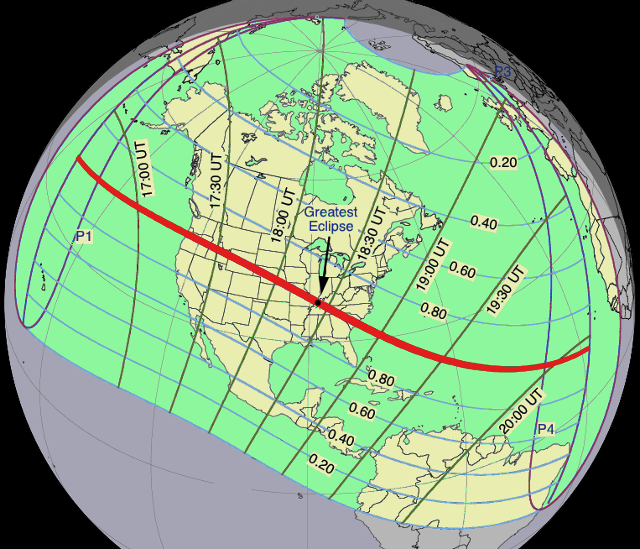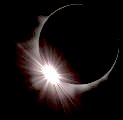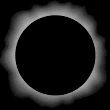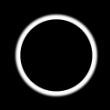A solar eclipse is a fascinating
phenomenon — our Sun, which is
normally so reliable, is suddenly stained black by the Moon.
Any solar eclipse is an interesting event, but a total solar
eclipse is the most spectacular astronomical phenomenon that
you'll ever see.
In the middle of the day, a shadow moves over
the Sun — for a brief minute or two, the sky darkens to the same level
as on a moonlit night; animals and birds are silent; everything seems to be
in suspension. The Sun has vanished, but its outer atmosphere — the
corona — is visible as a
ghostly halo around the black disc of the Moon, with streamers and ribbons of
faint light trailing off for millions of miles in the Sun's magnetic field.
Looking at the Sun, at any time,
is dangerous; and that applies during a solar
eclipse, just as it does on any normal day. So don't forget to read about
eclipse eye safety.
The Shadow on the Earth
As we've said, a solar eclipse always occurs at the New Moon. Now,
a New Moon happens every month, when the Moon is between the Earth and the
Sun, so that the near side of the Moon — the side we can see —
is in shadow. Usually the Earth and Moon aren't lined
up right to cause an eclipse; but once in a while (basically once every
6 months), the Sun, Moon, and Earth are lined up well enough so that the
Moon's shadow falls on the Earth. This is what causes a solar eclipse.
(You can learn why an eclipse doesn't happen every New Moon by reading
about eclipse cycles).
As explained in
Mechanics of Solar Eclipses, the
Moon's shadow during a solar eclipse has two parts:
- The outer — and largest — part of the Moon's shadow is known
as the penumbra. Any observers in
this area see only part of the Sun being covered by the Moon; hence, they
see a partial eclipse of the Sun. The penumbra is quite wide, usually
a couple of thousand miles or so across as it passes over the Earth.
- The smaller inner part of the Moon's shadow is known as the
umbra; any observers lucky enough
to be in this area see the Sun being completely blocked by the Moon, which is
a total eclipse of the Sun. The umbra is very small, perhaps
as little as a few miles across; it can be as much as a hundred miles,
or (rarely) a couple of hundred.
This means that a partial eclipse is usually seen over quite a
large area of the Earth; but when a total eclipse occurs, it is only
visible from a small part of the Earth (whereas its accompanying
partial eclipse is seen over a much larger area). However, the shadow
isn't simply a "spot" on the Earth; due to the movement of the Earth
and Moon, and rotation of the Earth, the shadow actually races across
the Earth's surface at around two thousand miles per hour, causing the
Moon's shadow to "write" a long track across the Earth.
As an illustration of this, the following map shows the area
of the Earth which will be touched by the Moon's shadow during the
total solar eclipse on 21 August, 2017.
The large green area is the area touched by the penumbra, which first
touches the Earth in the west, where the Sun is just rising, moves
west-to-east, and leaves the Earth again a few hours later, in the east
where the Sun is just setting. In this area, a partial eclipse will
be seen.

Map from the
NASA Eclipse siteGSFC Eclipse Web Site
The primary source of all the information on eclipses presented here at Hermit Eclipse. (NASA Goddard Space flight Center)
.
The narrow red band is the area touched by the
umbra; that is, the track of the total eclipse across the Earth, known as
the path of totality. As you can see, it starts in the Pacific,
races eastward across the US, and departs the Earth in the Atlantic
Ocean.
The reason that the partial eclipse area is rounded at the north
is that the penumbra almost falls off the "top" of the Earth and
into space. The reason that this doesn't happen exactly at the North
Pole is that the eclipse occurs in summer, so the Earth is tilted
towards the Sun at the north.
What Can You See?
What you will see depends, of course, on the type of eclipse
(partial or total); but also on where you are relative to the eclipse.
The following sections describe what you can see during an eclipse;
since a partial eclipse and the partial stages of a total eclipse are
essentially the same, both are described here.
Partial Eclipse: Beginning
During a partial eclipse, or the partial stages of a total eclipse,
the first sign of the eclipse on Earth is when the Moon's disc first
touches the Sun; this moment is known as
First Contact.
At First Contact, the Moon begins to take a "bite" out of the Sun; as
the eclipse goes on, this "bite" gets larger and larger.
Total Eclipse: Before Totality
In a total eclipse, as the moment of totality approaches, and the Sun
is nearly covered,
shadow bands might be seen; narrow bands of
shadow and light racing across the ground. These are multiple images,
caused by irregular refraction in the Earth's atmosphere, of the
remaining "slice" of the Sun.
If you are standing near or under trees, you may see multiple
images of the crescent Sun being projected on the ground by the
"pinhole camera" effect of the leaves. This is actually something you
can see on a normal sunny day, when circular Sun images can be
projected on the ground; but during an eclipse, the projected
crescents can be very distinctive. Try holding up a colander during
the crescent phases of the eclipse to see this effect!
As the Moon moves to cover the Sun, events proceed very rapidly.
The Moon's shadow may be seen rushing in very quickly from the west.
The remaining crescent of the Sun gradually shrinks to a sliver, and
then breaks up into distinct points of light, known as Baily's
Beads; these are caused by the Sun shining through valleys around
the visible face of the moon, for a few seconds before totality.
Because the Moon isn't equally "rough" all the way round, the display
of Baily's Beads isn't consistent, but depends on the angle from which
the Moon approaches the Sun. The Moon's irregularity can also have an
effect on the duration and width of the total eclipse.
When only one point of light is left, a beautiful diamond
ring effect may be observed, with the last brilliant point of
light transfixed on the Moon's outline. Then this last glimmer
vanishes, as the leading side or limb of the Moon touches the
farther limb of the Sun, at a moment known as Second Contact.
This is the first instant of the total eclipse.
Total Eclipse: Totality
During totality, the sky goes dark; not quite as dark as night, and
with strange shadow effects caused by scattered light from the edge of
the eclipse; the horizon still appears quite light, and the whole
landscape takes on a strange appearance. Birds go home to roost, bees
stop flying, and some flowers may begin to close as if for the night;
Nature seems to hold its breath.
In the sky above hangs the black disc of the Moon, surrounded by a
faint halo, like a negative Sun. The Sun's
corona, far too faint to be seen at
any time other than a total eclipse, streams out from the Moon in all
directions; some streamers reach several times the size of the Sun
before fading away.
For a few seconds after the beginning of totality, and again just
before the end, the Sun's lower atmosphere, the
chromosphere, may be
seen, as a reddish glow around the edge of the Moon. Some solar
prominences may also be
seen, as spectacular arcs of glowing red gas around the Sun.
Apart from the eclipse, the sky at totality is well worth a look.
Around the Sun, with the sky nearly dark, some of the brighter stars,
and particularly planets, may be seen. This may also be a rare chance
to see Mercury, since it is normally too close to the Sun; depending
on its position, it may be visible near the Sun.
Total Eclipse: After Totality
The end of the total eclipse is the reverse of the beginning.
Totality ends at
Third Contact, the moment at which the Moon
begins to uncover the Sun. Once again, a diamond ring,
Baily's Beads, and shadow bands may be seen.
Partial Eclipse: End
After third contact in a total eclipse, or in the later stages of a
partial eclipse, the Sun is progressively uncovered by the Moon, and
normal daylight returns. The shadow on the Sun shrinks until it
vanishes altogether at the moment of
Fourth Contact.
Annular and Hybrid Eclipses
So what about an annular eclipse? What's that all about?
and what about a hybrid eclipse?
An
annular eclipse is effectively similar to a total eclipse
described above, except that it occurs during a point in the Moon's orbit
when it is farther away from the Earth than average. This means that the
Moon is too small to cover the Sun up completely, so even though the Moon
is right in front of the Sun, there's a ring of visible Sun around the
edge of the Moon.
This, unfortunately, spoils the show; because the full intensity
of the Sun is always visible — even though the area of visible Sun is
reduced — it is not safe to look at directly, and the corona, prominences,
etc, will not be visible.
Still, an annular eclipse will make an interesting sight. Like a total
eclipse, an annular eclipse is accompanied by a partial eclipse covering
a much larger area.
A hybrid eclipse is an eclipse that is right on the boundary
between total and annular; so much so that the eclipse starts as
annular, changes to a total eclipse, then changes back to an annular
eclipse again before the end. The path of totality will be very narrow in
a hybrid eclipse. People in the path near
the middle of the eclipse will see a total eclipse, but normally this will be
a very short-lived eclipse; people near the ends of the path of totality
will see an annular eclipse.
How Long Does It Last?
A partial eclipse can last anything from a few minutes (for a very
small eclipse) to a few hours (for a larger eclipse); the duration you
will see will depend on how close you are to the centre of the
eclipse, with the longest duration near the centre.
The same applies to the partial stages of a total eclipse; however,
the real spectacle is the total phase. To see this, you have to be
within the path of totality; then you
will see a total eclipse which could last from a few seconds to a few
minutes, up to (very rarely) 7 minutes or more. (In the 21st century,
the longest total solar eclipse will be on the
22nd of July 2009, in China,
at 6 minutes 39 seconds; the next is the eclipse of the
2nd of August, 2027, in Africa and the
Middle East, at 6 minutes 23 seconds.)
The longest total eclipse will be seen in the centre of the path of
totality; the duration falls off away from the centre, and very rapidly
near the edges. So, if you're on the edge of the path of totality, you'll
see a very short total eclipse; but get reasonably close to the
centreline, and you should see close to the maximum duration.
Annular eclipses can last a lot longer — up to 12 minutes; on the
15th January 2010, an 11-minute
annular eclipse will be visible in the far East, the longest in the
21st century.









